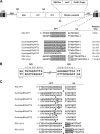Integration of rous sarcoma virus DNA: a CA dinucleotide is not required for integration of the U3 end of viral DNA
- PMID: 18768972
- PMCID: PMC2573277
- DOI: 10.1128/JVI.01353-08
Integration of rous sarcoma virus DNA: a CA dinucleotide is not required for integration of the U3 end of viral DNA
Abstract
The two ends of RSV linear DNA are independently inserted into host DNA by integrase in vivo. We previously showed that the range of U3 sequences that are acceptable substrates for integrase appeared to be greater than the range of acceptable U5 sequences in vivo. We have done additional experiments to determine which U3 sequences are good integrase substrates. On the U3 end, there does not appear to be a stringent requirement for the canonical CA, integrase can efficiently remove three nucleotides, and six nucleotides are sufficient to allow integration with reasonable, albeit reduced, efficiency.
Figures

References
-
- Chang, K. W., J. G. Julias, W. G. Alvord, J. Oh, and S. H. Hughes. 2005. Alternate polypurine tracts (PPTs) affect the Rous sarcoma virus RNase H cleavage specificity and reveal a preferential cleavage following a GA dinucleotide sequence at the PPT-U3 junction. J. Virol. 7913694-13704. - PMC - PubMed
Publication types
MeSH terms
Substances
Grants and funding
LinkOut - more resources
Full Text Sources

